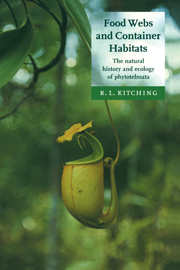Part V - Synthesis
Published online by Cambridge University Press: 26 August 2009
Summary
Treeholes abound in the primary dipterocarp forests of northern Borneo – but so does everything else. A hectare of forest we surveyed contained over 260 species of tree. The same patch of forest is home to almost 60 species of bird, 320 species of butterfly, 50 amphibians and forty-five reptiles. This superfetation of life is apparent to the field ecologist as nowhere else I have worked. Staggering up the steep track on the eastern shore of the Belalong, we were dive-bombed by dragonflies, a range of large and small butterflies, and by the more sinister large vespids that abound in these forests. We stepped over a flat-nosed pit viper coiled like a triangular spring beside the path, and over the very visible products of the resident herd of bearded pigs. We heard the overhead honking of rhinoceros hornbills, the accelerating crescendo of the call of the helmeted hornbill, and disturbed a flock of bushy-crested hornbills. Pigmy squirrels the size of mice headed up the tree trunks waggling their bottoms as they scent marked en route; flying lizards launched themselves and headed downwards in graceful swoops adjacent to the same trunks. The thing about the Bornean forests is that one can go on and on: the giant Campanotusants, the fantastic fungi, the dipterocarps themselves, forest dragons, pangolins, spiderhunters and tree holes.
Nowhere have I come across tree holes that contain such an abundance of life as in these Bornean forests – and a visible abundance at that.
- Type
- Chapter
- Information
- Food Webs and Container HabitatsThe Natural History and Ecology of Phytotelmata, pp. 291 - 292Publisher: Cambridge University PressPrint publication year: 2000



